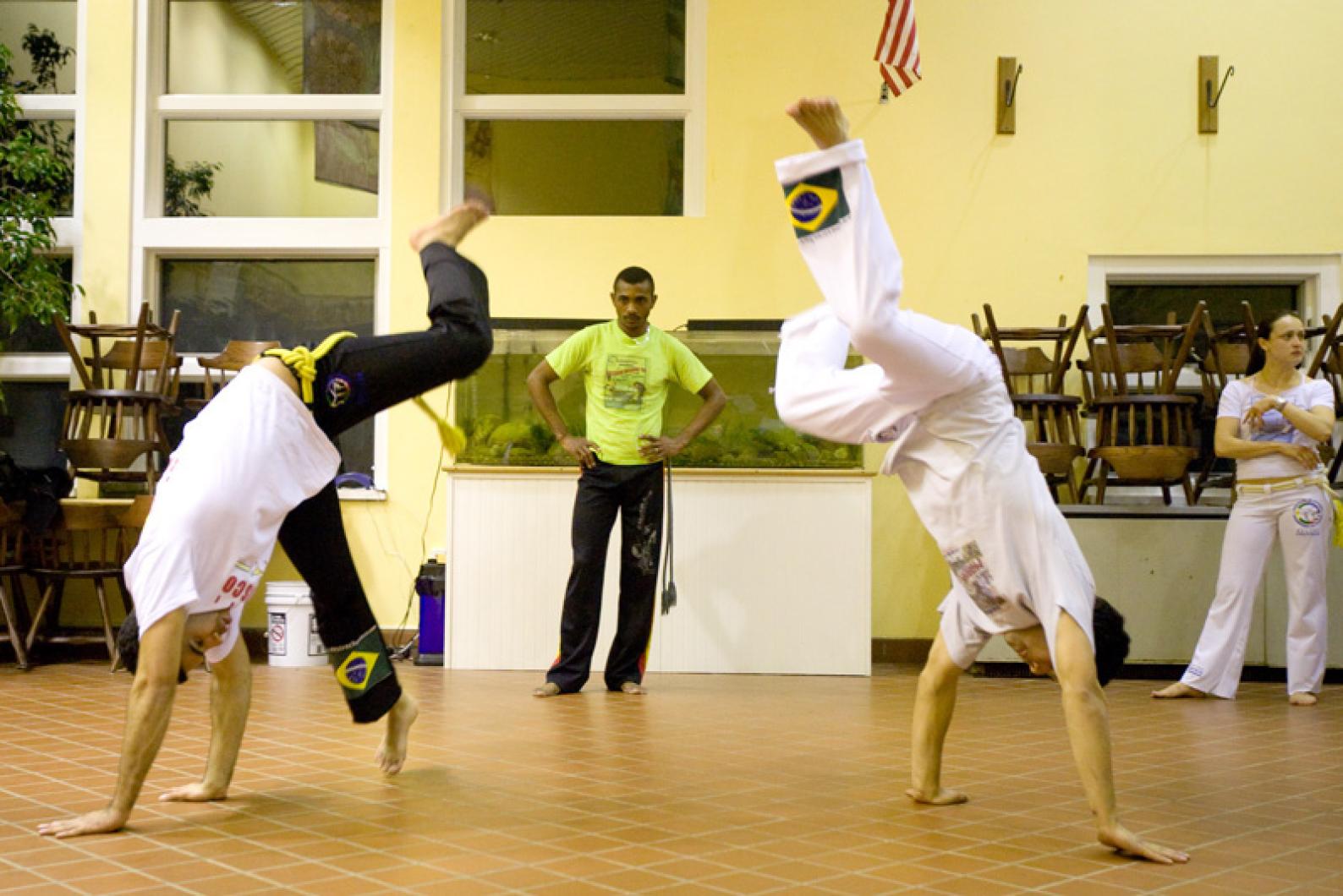It is early evening at the Martha’s Vineyard Regional High School and the halls are empty, except for the occasional sound of voices escaping from classrooms in use for the Martha’s Vineyard Adult Continuing Education program — a fast-paced conversation conducted in French, a writing student reading her latest composition aloud, an intent discussion about the Arab-Israeli conflict. And then someone opens the door to room 314, and there is the sound of drumming, singing and clapping. The Introduction to Capoeira class has begun.
Capoeira (phonetically, it’s Cah-pu-ay-dah or cup-where-tuh) is a dance form with an element of martial arts that was developed by slaves brought from Africa to Brazil. Watching the warm-up routines, it is hard to say whether the students are preparing to move in rhythm or to spar fiercely.
First there is a repetitive series of fast-paced sit-ups followed by a limbering swinging of the arms while standing, a routine which is repeated several times. The students then move through a rigorous stretching regime which involves students lying down, crouching or standing as the teacher instructs, sometimes with feet bent over head, sometimes holding themselves nearly perpendicular to the bare tile floor with only one foot on the ground, or holding deep squats while balancing on their toes, arms fully extended.
There is an occasional grimace or good-natured groan, but the group looks extremely fit, exhibiting even during the warm-ups a remarkable grace, derived from developing unusual strength, coordination and dexterity. The class is conducted to the lively rhythm of an Afro-pop beat playing on a boom box, heavy on percussion and chanting, and when the dancers hands are free — not holding their bodies off the ground — they clap and sing softly to the music.
“The music sets the pace,” says Pablo DeOliveira, while the class breaks for water. “Capoeira is like life. You’ll see in a few minutes when we start throwing kicks that they start flying pretty fast as the music speeds up. Just like in reality, you have to be ready for whatever comes at you, no matter how quickly.”
Adilson Ribeiro leads the class in Portuguese when the dancers are all Brazilian, while Mr. Oliveira works with the less experienced dancers, and acts as the translator for American students. He also works as a medical translator at the Martha’s Vineyard Hospital.
“We’re always looking to recruit new students to our program,” Mr. Oliveira says. “I’m trying to dispel the myth that you have to be fit to begin Capoeira. It might look intimidating but anybody can start. We have men and women learning, Americans and Brazilians. It’s something that you can do in order to get fit, through slow training and repetition.”
The class reassembles and begins the next phase of their workout, which resembles a combination of judo and modern dance. The beat of the music is faster now and the students sway rhythmically side to side, clapping and chanting — and then suddenly twirl in unison, thrusting their arms up and back in a feint and parry motion, as if fending off an unseen attacker. The moves are repeated again and again before they proceed to standing and walking on their hands, spinning in slow cartwheels across the room. They are now prepared for the dance, or “games,” as Mr. Oliveira calls them.
“We might look like enemies when we are facing each other in the huddle,” Mr. Oliveira says, “but we are friends and partners.”
The six performers form a circle in the center of the room, at first holding hands and then breaking apart, dancing in place, throwing an occasional punch that is not intended to land, while another ducks the stylized blow in an exaggerated manner, clapping, joking, laughing and spinning a cartwheel every once in a while.
This is clearly the moment they have been waiting for. Two people move into the middle of the circle as the music picks up tempo. They crouch low and slap hands together before coming up in what looks like a dance to the death cheered on by the others still forming the perimeter.
This is a dance of attack and retreat, feint and thrust, duck and parry. The movements are improvised, not choreographed, but all are built on the motions that they have repeated again and again over the previous hour. The action builds in speed and ferocity, attacking kicks progress from low and sweeping to full-body, spinning-over-the opponent’s-head maneuvers, while the defense proceeds from dodging and ducking to backward somersaults and handstands to avoid the blows that never strike.
Guided by an undetectable impulse, one performer sidles into the huddle while one dances out and the game continues, going round and round as each student takes successive turns in the circle, engaging in what is as much a ritualized bout as it is a dance, something akin to Japanese Kabuki.
The class comes to an end when all of the students have paired off with each other — and judging by their camaraderie as they make for the door, it is clear that Mr. Oliveira is right: These are partners in a game, not combatants, and they will all be back next week.
For information about studying Capoeira through the Adult Continuing Education program or at other locations on the Island visit mvcapoeira.com. For information about other classes on a wide variety of subjects visit acemv.org. Rise dance studio in Vineyard Haven also offers Capoiera classes.




Comments
Comment policy »